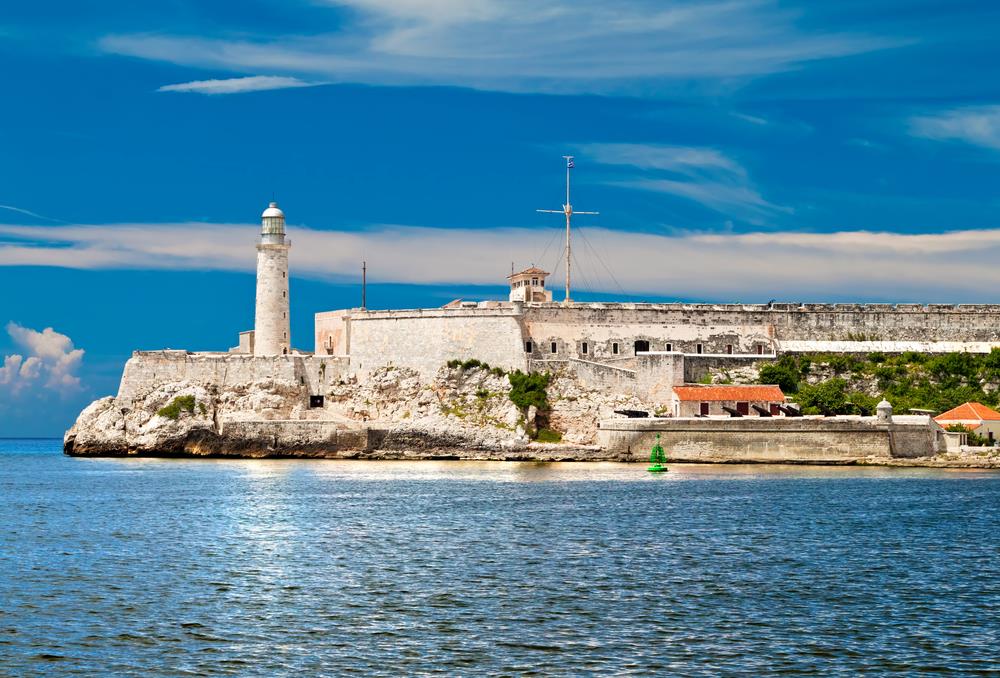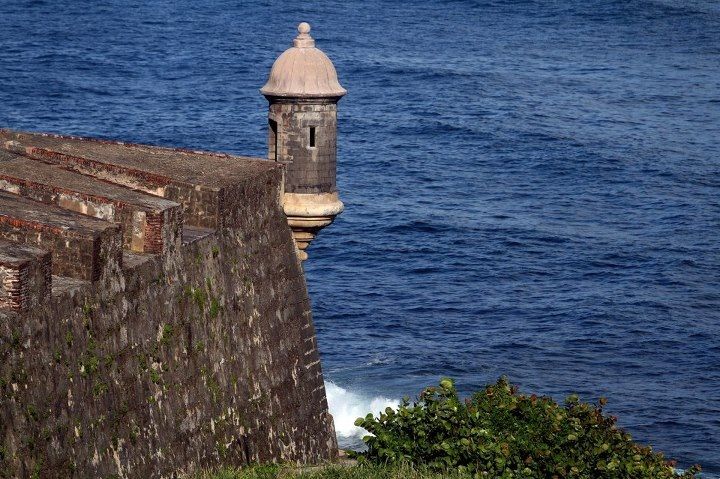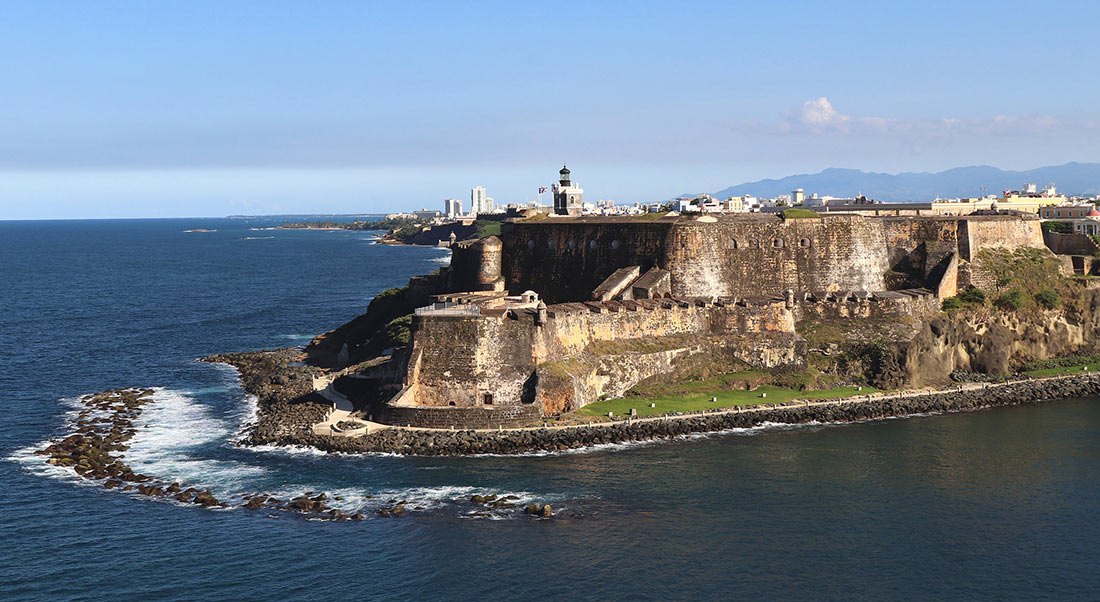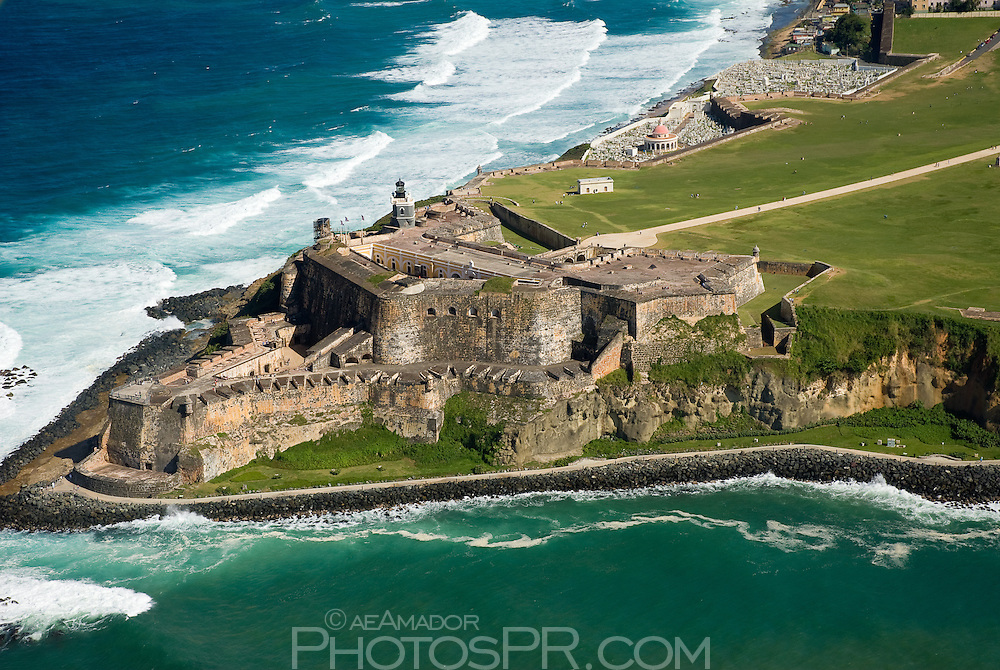El morro de puerto rico: San Juan National Historic Site (U.S. National Park Service)
El Morro Fort, Old San Juan
849
shares
Founded in 1521, the city of Old San Juan was originally conceived as a military stronghold for the Spanish colony of Puerto Rico.
Naturally, the whole islet of San Juan was bordered with a massive, yet intricate fortification system that protected this strategic location in the Caribbean Sea, as well as held the riches Spain needed to gain world power.
Out of the fortification system, the Castillo San Felipe del Morro, also known as El Morro, is the most important structure due to its size and location.
The lower level of El Morro looking towards the Atlantic Ocean.
El Morro is one of the most well-known attractions in San Juan and Puerto Rico. Its iconographic shape and character represent and pay tribute to five centuries of Spanish colonial and American history that speak about the strategic importance of the island to its mother nations.
Puerto Rico was the first large island with food, freshwater, supplies, and shelter encountered by weary sailors from Europe.
Its geographic position midway between Europe and the New World, its location on the course of the trade winds, and its deep, easily defended San Juan Harbor gave Puerto Rico great military, economic, and strategic importance.
View towards the entrance of San Juan Bay. El Morro and El Cañuelo (located on the small island to the left) cross fired enemy ships that attempted to enter the bay.
Located on the headland overlooking the entrance to San Juan Bay, El Morro was built to protect the city of San Juan from seaborne enemies.
When seen from the sea, you get the sense of how this imposing fortress commanded the respect of those that attempted to defeat it.
The great lawn before the entrance of El Morro helps set this structure as an iconic element in Old San Juan.
The large green field in front of the fort was strategically planned by the military and used as a camping ground for the troops during WWII.
Today it is an extremely popular spot for locals to picnic and fly kites. Including its greenfield, El Morro has the distinction of being the largest fortification in the Caribbean, with a total of 74 acres.
The entrance of El Morro with classical Greek and Roman design features to express power in size and imperialism.
When you enter, the first area you see is the Main Plaza. This was the area where troops would assemble for parades and daily inspection.
The rooms around the sides were used as living quarters, storerooms, chapel, powder magazine storage, prison cells, and canon-firing positions.
The Main Plaza of El Morro
Here you can watch a short video about the history of the fort. Park Rangers give a short orientation talk on the hour in English and 30 minutes past the hour in Spanish.
Otherwise, you can explore this magnificent fortification on your own by going down the staircase/ramp that takes you down to the lower level.
The staircase loophole that connects the main plaza with the lower level.
At the lower level is the Bateria de Santa Barbara – the most powerful cannon battery of the fort. Here you will find the iconic Garitas (sentry boxes) along the walls, as well as the ‘Water Battery’.
The ‘Water Battery’ got its name from the fact that the cannons were placed so close to sea level that they could easily hit the hulls of any ships that attempted to get too close to the fort.
A close look at a Garita (sentry box). These were strategically placed along the walls of the fort and walls surrounding Old San Juan.The lower level cannon that served as protection to the bay and the fort.Thresholds connecting various rooms on the lower level. The lower level also had additional living quarters for militants on duty.
Back in 1539, El Morro was just a simple tower. The six-level layout seen today was designed several years later in 1587 by engineers Juan de Tejada and Juan Bautista Antonelli based on the established Spanish military fortification design principles of that time period.
A second period of major construction followed in the 1760s to the 1790s.
Rising 140 feet above the sea, its 18-foot-thick wall proved a formidable defense.
During WWII this fort was used by the United States to protect the port from submarines or other attacks.
The large, concrete structure with dark slits was built by the U.S. Army as a coastal artillery observation post. It definitely looks different from the 16th century Garitas.
Old Walls of El Morro Contrasted with the WWII artillery addition (top left). In 1992 the fortress was restored to its 1800’s historical form to commemorate the 500th anniversary of Christopher Columbus’s discovery of Puerto Rico.Garita of El Morro contrasted with the complex shapes of the thick walls.
In addition to its rich history, El Morro is full of interesting, complex views of the fortification and the city, contrasted with the smooth views of the Atlantic Ocean and San Juan Bay.
So, make sure to have your camera ready as there are many great photo opportunities.
1539, Construction of Castillo San Felipe del Morro started.
1595, First English attack by Sir Francis Drake. The gunners of El Morro thwarted Drake with their cannons and a metal chain stretching across the entrance to the bay.
1598, Second English attack by Sir George Clifford (Duke of Cumberland). El Morro fell as the attack was made by land instead of by sea. The Duke occupied the fort for 6 months but abandoned it after an outbreak of dysentery. Fort returned to the Spaniards.
1625, Failed attack by the Dutch, under Boudwyn Hendrick.
1634, The construction of the city walls started, as well as a second fortress, Castillo San Cristobal.
1790, Major construction at El Morro and city walls completed.
Cannon pointing towards the San Juan Bay entrance.
1797, The British, led by Sir Ralph Abercromby, invaded Puerto Rico and once again fail in their attempt to take San Juan and El Morro. The battle of 1797 was one of the largest in Puerto Rico’s history and is reenacted every year on the grounds of El Morro and throughout the city of San Juan.
The battle of 1797 was one of the largest in Puerto Rico’s history and is reenacted every year on the grounds of El Morro and throughout the city of San Juan.
1898, El Morro fought its final battle when the United States Navy bombarded the fort during the Spanish–American War. The fort suffered substantial damage from the shelling. Puerto Rico becomes U.S. territory. El Morro gets repaired and the lighthouse is added.
1942, As part of the USA’s World War II preparations, El Morro was fortified with a concrete artillery observation posts and an underground bunker.
1943, Name changed to Ft. Brooke in honor of the first American governor. Later changed back to El Morro.
1983, Designated as a UNESCO World Heritage Site.
The strategically placed circular sentry boxes called, Garitas, have become the national symbol of Puerto Rico.
Essential Info: Logistical Tips and Tricks to Book your Trip to Old San Juan
Location: Old San Juan, Puerto Rico
Operation Hours: 7 days/week from 9:00 am – 6:00 pm. The fort is Closed on New Years Day, Thanksgiving, and Christmas Day.
The fort is Closed on New Years Day, Thanksgiving, and Christmas Day.
Cost: Adults $7. The entry ticket is valid for El Morro and San Cristobal Fort within the same day. Children 15 and under enter for free.
Phone Number: 787-729-6777
Website
BOOK YOUR FLIGHT
Find a cheap flight by using Skyscanner or Kayak. These are two of the sites I use the most due to their exhaustive search on several websites and airlines around the world. They usually bring the cheapest fares.
BOOK YOUR ACCOMMODATION
If you’re looking to save money by staying at a hostel, HostelWorld has the largest inventory of hostels. On the other hand, Airbnb offers a wide variety of rooms and apartments at affordable prices. (Get $40 off your first Airbnb booking with this link. )
)
For hotels, guesthouses, and other types of accommodation, I also recommend Booking.com. They usually have the cheapest fares for guesthouses and hotels. I always book my hotels with Booking.com.
DON’T FORGET YOUR TRAVEL INSURANCE
Travel insurance with comprehensive coverage will protect you against unexpected events like theft, cancellations, injury, and illness. I use World Nomads and highly recommend it.
If you’re a nomad and travel often or long term, then SafetyWing could help you save a lot of money on travel insurance.
FIND THE BEST TOURS AT THE BEST PRICES
If you’re looking for the best day-tours and cheapest ticket entrances to local attractions, I recommend checking Viator, as they have the largest selection of attractions, passes, and activities all around the world.
OTHER TRAVEL AND MONEY-SAVING TIPS?
Lastly, check out my resources page for some of the best products and companies to use for your trip. If you like saving money (like I do!), then this page will help.
849
shares
El Morro – Etsy.de
Etsy is no longer supporting older versions of your web browser in order to ensure that user data remains secure. Please update to the latest version.
Take full advantage of our site features by enabling JavaScript.
Find something memorable,
join a community doing good.
(304 relevant results)
Puerto Rico: El Morro in defense of the island
“I burned the beard of the Spanish king!” – Francis Drake.
However, Drake could not take El Morro, a Spanish fortress on the island of Puerto Rico, and went to rob other Caribbean colonies. And besides the famous pirate, the fort withstood more than one attack from the Dutch fleet, a bunch of restless British, and later from the American Atlantic squadron at the end of the 19th century. And why, one wonders, did they all climb here?
Well, of course, because of the treasures of the Spanish crown, plus the island was convenient to use on the waterway to Europe as a “base” for a warehouse of loot in the newly discovered Latin American countries.
On his second voyage to the shores of the West Indies, Christopher Columbus was the first European to set foot on Puerto Rico, a small rectangular island in the very northeast of the Caribbean Sea. The local Indians called their island Boriken, but Columbus gave it the name San Juan Batista (“Saint John the Baptist”). Soon, the city of Puerto Rico appears on the island (that is, “rich harbor”). Subsequently, cartographers mixed up the names, and the name San Juan was assigned to the city, and Puerto Rico was assigned to the island.
Subsequently, cartographers mixed up the names, and the name San Juan was assigned to the city, and Puerto Rico was assigned to the island.
It was to protect San Juan that the powerful, 6-level fort of El Morro was erected, the construction of which began in 1539. Over the next 300+ years, Spain more and more hangs El Morro with different “chips”: either the thickness of the walls is increased from two meters to five and a half, or in general, it was decided to enclose the entire San Juan with a huge wall, the construction of which took 48 years.
All this – the huge city walls, the San Cristobal Fort built along the way to repel ground attacks, and, finally, El Morro, armored from all sides, protected San Juan until the very end of 19th century.
But in 1898, the Spanish-American War broke out, ending Spain’s dominance in Caribbean waters.
In January, during the unrest in Havana, Washington decides to send the battleship “Maine” there in order to show concern to the US and protect American citizens (Christmas tree, nothing has changed in a hundred plus years). After the explosion of the ironclad on February 15, hostility towards Spain in American society began to grow. Adding fuel to the fire was the fact that, a week before the bombing, the New York Journal published a stolen letter by the Spanish minister in Washington, in which he belittled the current President McKinley and expressed confidence that Spain was ready to fight if the war will happen.
After the explosion of the ironclad on February 15, hostility towards Spain in American society began to grow. Adding fuel to the fire was the fact that, a week before the bombing, the New York Journal published a stolen letter by the Spanish minister in Washington, in which he belittled the current President McKinley and expressed confidence that Spain was ready to fight if the war will happen.
Relying on militant sentiments, the McKinley government, under the pretext of supporting the national uprising in Cuba (which had been going on since 1895 for the independence of Cuba), declared war on Spain. During the hostilities, the United States captured Cuba, Puerto Rico, and the Philippines, which belonged to Spain since the 16th century. According to the Peace of Paris, which ended the war, Spain renounced the rights to all these colonies, which were declared “free states”, but found themselves, however, under one form or another of US control.
So, the beautiful El Morro has become the American “Fort Brook”, and the green lawn in front of it has been planted with palm trees and turned into a golf course.
Today, the flags of Puerto Rico, the United States and the Burgundian Cross, once used by the Spaniards, fly over the fort.
The struggle over the status of Puerto Rico does not stop. A certain part of the islanders is striving to turn the country into a US state. Their interests are represented by the Republican Party under a flag of blue, white and red horizontal stripes.
The independence camp is small and fragmented. Among them is the Communist Party, revived in 2010 (together with the political school named after Vladimir Lenin), whose flag repeats the design of the national flag, but, paradoxically, the red color has been eliminated from it. It is the only Communist Party flag in the world that does not have red on it. The majority of Puerto Ricans, participating in periodic referendums, support the idea of maintaining the current status of the country.
Entrance to El Morro is $3 (children under 15 free). In the very center is the main square of the fortress, where parades and celebrations take place. A well was also dug here, which provided rain drinking water to all the defenders of the fort. The premises around were used as barracks, powder magazines, prison cells and firing points.
In the very center is the main square of the fortress, where parades and celebrations take place. A well was also dug here, which provided rain drinking water to all the defenders of the fort. The premises around were used as barracks, powder magazines, prison cells and firing points.
Going down the stairs to the lower level, you can get to the St. Barbara Battery, the most powerful cannon battery in the entire fort. Most of the cannons here are located almost at sea level in order to be able to fire on the bottoms of ships that have come too close to the fortress. True, the battery participated in hostilities only twice. The rest of the time it was teachings, teachings, teachings.
And perhaps the most romantic element of the fortress – garitas . The guardhouses “garitas” have become a national symbol. Their images can be found in any tourist catalogue, on postcards, on license plates and various souvenirs. And modern young Puerto Ricans love to kiss there 🙂
And modern young Puerto Ricans love to kiss there 🙂
And speaking of toilets. No, but what? Enough history for us, it’s time for the essentials. There are two of them, and from the windows of both there are simply crazy views of the Atlantic. So do not rush to call the police when you see a joyful person with a camera coming out of the toilet. This is not a psycho and not a pervert. He just liked the landscape 😉
Location: Puerto Rico.
Like this:
Like Loading…
caribbean, island, museum, puerto rico Puerto Rico stock photo ©demerzel21 98027644
Sign In to See November Specials
Images
VideosEditorialMusic & Sounds
Tools
Business
Our prices
All images of
Log in
I accept the terms of the User AgreementReceive news and special offers
Castillo San Felipe del Morro is also known as Fort San Felipe del Morro or Morro Castle at dusk. This is a 16th century citadel located in San Juan, Puerto Rico.
This is a 16th century citadel located in San Juan, Puerto Rico.
.
— Photo by demerzel21
Buy this image for only €1 with our Flexible Plan
Get
also known as San Felipe del Morro Fort or Morro Castle at Dusk. This is a 16th century citadel located in San Juan, Puerto Rico.
.La Fortaleza (Fortress) is the official residence of the Governor of Puerto Rico. It was built between 1533 and 1540 to protect the harbor of San Juan. Palacio de Santa Catalina (Santa Catalina’s Palace)
).The Cape Coast Castle is a fortification in Ghana built by Swedish merchants to trade in timber and gold. The structure was later used in the transatlantic slave trade.
.Castillo San Felipe del Morro is also known as Fort San Felipe del Morro or Morro Castle at dusk. This is a 16th century citadel located in San Juan, Puerto Rico.
.Castillo San Felipe del Morro is also known as Fort San Felipe del Morro or Morro Castle at dusk. This is a 16th century citadel located in San Juan, Puerto Rico.

.Castillo San Felipe del Morro is also known as Fort San Felipe del Morro or Morro Castle at dusk. This is a 16th century citadel located in San Juan, Puerto Rico.
.Cape Coast Castle is a fortification in Ghana built by Swedish merchants to trade in timber and gold. The structure was later used in the transatlantic slave trade.
.Castillo San Felipe del Morro is also known as Fort San Felipe del Morro or Morro Castle at dusk. This is a 16th century citadel located in San Juan, Puerto Rico.
.City walls and observation deck of San Juan, Puerto Rico
.Kofedralny yard in the Elmina castle (aka the castle of St. George). Located on the Atlantic coast of Ghana, west of the capital Accra. Included in the UNESCO World Heritage List
.Castillo San Felipe del Morro is also known as Fort San Felipe del Morro or Morro Castle. This is a 16th century citadel located in San Juan, Puerto Rico.
.Castillo San Felipe del Morro is also known as Fort San Felipe del Morro or Morro Castle at dusk. This is a 16th century citadel located in San Juan, Puerto Rico.